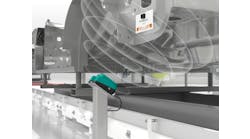Radio-frequency identification (RFID) has been with us for a long time, but what is it?
Radar was developed during the Second World War and was used to track aircraft, both friend and foe. The concept was to project radio waves from a transmitter and read the returning waves that would happen when the projected waves bounced off an object in its path. The presence of return waves would identify that an object is within the range of the transmitter. By projecting the waves from a rotating transmitter, the immediate airspace of the transmitting station could be monitored for aircraft activity. Technically, this was the first use of RFID.
Officially, inventor and scientist Harry Stockman is credited with inventing RFID in 1948. A long-range version of the original radar technology, called Identification Friend or Foe (IFF), was introduced in 1959 and has been an essential part of both aerospace and military applications ever since.
In 1963, inventor RF Harrington came up with a way to imbed scattered data and identification into the radio waves, and, a short three years later, the first commercial use of RFID for security checkpoints and anti-theft devices occurs.
An RFID transponder was introduced in 1973, and Los Alamos Technologies releases information about RFID technology to the public, allowing others to develop products utilizing the technology. The first use of an RFID license plate was in 1977.
By the year 2000, more than 1,000 patents had been registered for the use of radio-frequency identification. Present-day RFID uses a microchip to identify and track items, but the general concept has remained the same since the dark days of World War II.
The most common place we see RFID in use might be the retail world where everything from clothing and electronics to high-priced cosmetics contains small RFID tags that are used to help identify attempted thefts. One other place that RFID is in general use is radio transponders used on toll roads.
Any company not involved in the use or deployment of RFID would have definitely missed the train on this fast moving technology.
[pullquote]RFID has been a boon to any industry that produces products. Tags can be placed in cases, containers and pallets to increase traceability of products. The healthcare industry makes extensive use of RFID tags to identify and track samples taken from patients during the diagnosis of health-related issues.
The development of technology around the RFID concept has opened up the possibilities, and they are worth identifying. The first radar systems simply sent out radio waves and looked for return waves of the same frequency and wavelength as the transmitted waves to identify that an object was within the range of the radar station.
[javascriptSnippet ]
Identification Friend or Foe (IFF) systems enhanced that concept by still using radar to identify that an aircraft is in the scanned range but then sends out an interrogation (who is this?) signal that will be answered by the receiving aircraft.
By using a transponder to listen for an interrogation signal, the aircraft then sends a response that identifies the aircraft. Any aircraft that do not respond to the interrogation are assumed to be unfriendly, or a foe. Further measures are then taken to positively identify the “unfriendly” aircraft to make sure that it isn’t a case of a malfunctioning transponder or a smaller aircraft that doesn’t have one at all.
One of the greatest advancements in RFID technology is the ability to read and write to a tag. Early RFID tags had a simple “message” permanently written to the contained microchip. Like the license plate on a car, these tags simply identified the tag when read. No other information was available, so these tags could really only be used to identify and track items in a closed system like a warehouse.
Expanding the data on a tag to include not only the unique identifying record (the license plate) but also a host of other data fields increased the capabilities of these tags to carry specific information about the tagged object.
With read/write capabilities, the tag could be used to identify the journey of the object through a process, adding information as it passes each step in the manufacturing process through to the finished product. That same tag stays with the product after it leaves the manufacturing facility and can be used by regulatory agencies to track potential product recalls or even the unlawful possession of controlled substances like medication and ammunition.
RFID tags with read/write capabilities can be found in devices like key fobs used by an employee to gain access to a building or, perhaps, a special access area within a facility. This same device can also be used by a manufacturing facility to track changes made by maintenance personnel to production equipment. The employee would use the personal key fob to gain access to critical process variables on a machine, and these changes could be stored in a monitoring system for future reference or change tracking purposes.
In critical processes, such as a nuclear plant or water treatment facility, the use of individual key fobs with read/write capabilities adds a level of accountability to potential process changes where they may introduce risky results that may endanger machinery or personnel.
Another example of the use of RFID is in the coding of safety switches used on packaging equipment. Historically, an access door switch would be a physical switch that is activated by a mechanical feature mounted to the frame of the machine.
These devices were inherently finicky and would often get out of alignment. It was easy to defeat these switches by simply tying the trigger mechanism to the switch itself so that it is permanently activated. This is extremely dangerous, however, because someone could open that door or access panel without the machine shutting down since the switch condition is satisfied and keeps the control relay engaged.
Noncontact switches came into existence to solve the misalignment issue, but they, too, were an issue because the flag part, replacing the physical feature on the machine, could be again tied to the switch, fooling the system into thinking that the door panel was still closed because the switch was still making contact with the actuator.
The introduction of RFID applications to safety switches introduced the relative safety of having to have an actuator that had to “talk” to the switch. With magnetic reed switches, a common safety switch, any object that completes the circuit could be used to bypass the safety function, but, with an RFID safety switch, the actuator, containing the RFID chip, had to match the reader—switch body— technology. This means that as the switch the actuator has to be matching manufacturer and model.
To further ensure the safety function, switch/actuator combinations can be selected that have unique ID numbers. This means that the switch and actuator must be a matching pair.
With the unmatched pair, any actuator of the same model number as the switch can activate any switch in the system. Mechanics or technicians could carry a spare actuator in their pockets and use it to defeat the intended safety function.
With the unique pair, only the actuator that is electronically keyed to the switch can close the safety circuit. The downside of this approach is that a damaged switch or actuator means that they must be replaced as a pair.
It would be remiss to talk about RFID tags and not mention barcode tags. While barcode tagging has moved from one-dimensional to two-dimensional— think of a UPC code on a carton versus a matrix code made up of a grid of light and dark squares— it still relies on a central data system to store the information associated with the barcode.
Unlike a read/write RFID tag, a barcode must either be reprinted or a centralized database must be updated with new information as the product makes its way through processing. This means that there must be access to that database at every step in the process, all the way to the retailer or end destination of the product.
With a read/write RFID tag, more information can be added to the tag as the product moves through the process and out to its final destination. At any point in the journey, an RFID reader can read all of the data that is written on the tag without needing to connect to a central database to look up the associated data for that product tag.
As with any technology, the passage of time translates into the evolution of the technology. Memory chips get smaller, and the amount of data that can be stored on a device gets ever larger.
It is amazing that the radio waves that were deployed to identify objects occupying the air space around a radar station would lead us to the technology that identifies and tracks products and associated information through pretty much every aspect of our commercial and personal lives. The possibilities are seemingly endless.






